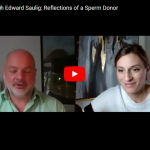On November 9, 2007, before a large audience in the Bay Area of California, speakers that would normally have plenty to disagree about came together in unity, with a common goal: to call for a moratorium on the exploitation of women through the trading of human eggs. This is a fight to raise awareness and promote safe research and regulation of this industry.
Jennifer Lahl, the National Director of the CBC, moderated a panel of five presenters, representing a wide range of experience and perspectives.
- Diane Beeson, Ph. D., Director, Hands Off Our Ovaries
- Dana Cody, Esq., Executive Director, Life Legal Defense Foundation
- Nicole Marchand, Student, San Francisco State University, Hand Off Our Ovaries Board of Directors
- Calla Papademas, Stanford grad and survivor of health problems related to egg donation
- David Prentice, Ph. D., Family Research Council
But what’s the controversy over trading human eggs? Well, for such a serious international problem, it’s alarming how few people even recognize this as an issue. The event’s panelists clarified the facts, and cut through the often disingenuous media fog that too often clouds the issue to the public.
Dr. Prentice led off the discussion, noting the promise of stem cells in treating injuries and diseases, some currently without cure. In order to continue embryonic stem cell research (ESCR) in this field, researchers need the raw material for developing effective therapeutic treatments. And human eggs are the hot commodity. And they have only one source: the female body.
For effective research, Prentice explained, up to 100 eggs are required per patient. Scientists agree that as many as 1.7 billion human eggs would be needed to fully treat just one disease group in one country. So that would require 170 million women of child-bearing age to step forward and donate 100 eggs. There aren’t even that many fertile women in the United States alone. Now you should have a better idea of the international scale of this problem; women everywhere could be adversely affected.
Prentice went on to offer a more viable and ethically-sound solution: adult stem cells. Adult stem cells – many donated by the patients themselves – have already been effective in treating at least 73 scientifically peer reviewed cases of disease and injury, producing astounding results of healing and health improvement. Compared to ESCR’s zero cases of successful treatment, it seems we have a safer and more effective alternative than politicians and stem cell enthusiasts are willing to admit.
Panelist Dana Cody of Life Legal Defense Foundation represented the legal front in the battle to regulate egg trade. Cody assisted in litigation to challenge California’s Proposition 71. Prop 71 was approved by a small majority of California voters in 2004 and has become the groundbreaking initiative that will forge the way for embryonic stem cell research to move forward . Unable to repeal the legislation, women are left to fend for themselves. Cody suggests that women should now take initiative to become educated on what the California Institute for Regenerative Medicine (CIRM) is doing to regulate and oversee the research under Prop 71, and demand measures to protect the women affected. At a time when a shortage of eggs is of increasing concern to researchers, women must be aware that their health and lives are at threat by legislation like Prop 71.
Dr. Diane Beeson spoke from years of experience in the area of women’s health and fertility, providing a sociological history of the egg trade up to the present-day push for therapeutic cloning research. Beeson cited a moment of personal realization that Prop 71 allocates “a vast amount of money to prioritize the most speculative and least successful form of stem cell research – embryo cloning research.” As a lifelong pro-choice advocate, she is deeply concerned that such experiments would require huge amounts of human eggs “and that acquiring these eggs would jeopardize the health of large numbers of young women.”
The most powerful appeal to action came when listening to Calla Papademus, who related her experiences as a respondent to an egg donation ad. Papademus fell into the target market for egg donors. Motivated by unselfish, altruistic desire to “help make an infertile couple’s dream come true” she signed up, and began self-administering hormone injections of Lupron immediately. She immediately experienced serious side effects, including debilitating migraine headaches, loss of vision, and nausea.
Calla’s experience with egg donation is indelibly marked with irresponsibility by the donation agency, which has forever changed Calla. When she had questions about the consent form, she was hurried and encouraged to “just sign it.” After repeated calls complaining of her side effects, a nurse from the agency finally responded that it was all part of taking the Lupron, and that she should continue to endure taking it. Ultimately, the agency’s inadequate screening process and neglect cost Calla the ability to naturally conceive children. Due to a small tumor on her pituitary gland, she had experienced irregular menstrual cycles as a teen, which is an immediate disqualification as an egg donor. A simple question by the agency (which it denies having neglected) for Calla – but through neglect, the Lupron enlarged her tumor, which cut off the blood supply to her brain, causing a major stroke and paralysis.
The evening ended with a call to action from Nicole Marchand, a student and Hands Off Our Ovaries intern. After hearing stories like Calla’s, Marchand responded with action, and is calling others to join her. Formed in 2006, Hands Off Our Ovaries “seeks a moratorium on egg extraction for research purposes until such time as global discourse and scientific research yields information sufficient to establish adequate informed consent.” Marchand and her colleagues reach out to other young women on college campuses who are vulnerable to solicitations for their eggs, speak to classes, post warnings, and continue to fight the human egg trade through events such as this.
Humanity continues to progress scientifically and technologically – developing new research methodology, unprecedented procedures, and dreaming “bigger and better” dreams about our human future. So much is unprecedented. And therein lies the problem. Without the foreknowledge to see the effects (and side-effects) of this research for the short- and long-term, we continue to risk lives and resources for the sake of progress.
The message from Trading on the Female Body was clear: At a time when government and industry do not act to protect women, it is critical that as human beings, we must act to protect each other, continue to raise awareness, and seek to equip individuals and communities to affect change.
Author Profile
Latest entries
 Sperm DonationMarch 15, 2022Venus Rising with Edward Saulig: Reflections of a Sperm Donor
Sperm DonationMarch 15, 2022Venus Rising with Edward Saulig: Reflections of a Sperm Donor BioethicsMarch 13, 2022Dr. C. Ben Mitchell: 2022 Ramsey Award Winner
BioethicsMarch 13, 2022Dr. C. Ben Mitchell: 2022 Ramsey Award Winner #BigFertilityMarch 10, 2022Documentary Explores One Woman’s Journey through Egg Donation
#BigFertilityMarch 10, 2022Documentary Explores One Woman’s Journey through Egg Donation BioethicsMarch 9, 2022Questioning the “Science” of the Gender Industry
BioethicsMarch 9, 2022Questioning the “Science” of the Gender Industry

